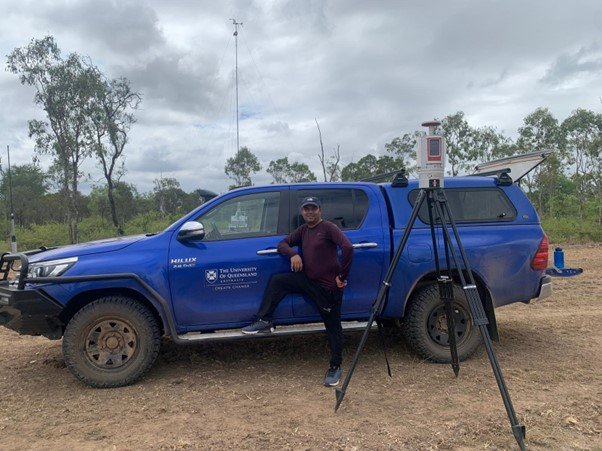Shedding Light on Leaf Area Density Estimation
HDR Spotlight: Raja Ram Aryal
Raja in the field ready for some terrestrial laser scanning.
Data capture with terrestrial laser scanner.
Spectrometer data capture anaylsis.
Raja Ram Aryal, an EORC PhD student, is making significant advances in the field of remote sensing and forestry applications with his innovative research on Leaf Area Density (LAD) estimation using Lidar technology. His work, which focuses on the voxel-based approach to LAD estimation, is set to enhance the accuracy of biophysical variables crucial for climate change models.
Raja's research explores the intricacies of how vegetation characteristics such as element size, leaf proportion, woody volume, leaf orientation, and distribution within a voxel impact LAD estimation. "During this HDR project, I am examining Lidar-based Leaf Area Density estimation using a voxel-based approach," Raja explains. His goal is to refine the accuracy of LAD measurements, which are vital for terrestrial biosphere models and Earth System Models.
Raja's journey into this focused field began during his graduate studies, where he gained experience working with Lidar technology. "I started exploring Terrestrial Laser Scanner in my department in Nepal (Forest Research and Training Centre, Ministry of Forests and Environment) and was fascinated by the application of digital twins in forestry," he recalls. His interest deepened as he reviewed the Radiative Transfer Model and recognised the importance of 3D structural orientation of leaves in retrieving greenness and photosynthetic-based vegetation indices.
Raja employs a quantitative, computational experimental methodology, which includes collecting TLS data, simulating Lidar data, and generating reference data using voxel-level ray tracing. He conducts sensitivity analysis on vegetation characteristics and validates his findings with error metrics. However, the journey has not been without challenges. "As a non-native English speaker, it takes me time to understand the people around me. Programming is tricky for a non-programmer like me," Raja admits. Additionally, adapting to high-power computing setups and returning to academia after a seven-year gap posed significant hurdles.
One of Raja's notable discoveries is identifying the Clumping Index as a primary factor influencing errors in LAD estimation using Lidar data. "I tested all vegetation characteristics and figured out that the Clumping Index plays a major role," he notes. Raja is now developing a deep learning model to determine the clumping index per voxel, which promises to enhance the precision of LAD measurements.
Raja believes his research will have far-reaching implications. "The estimation of LAD using the clumping index gives a more accurate LAD, which is one of the biophysical variables in the terrestrial biosphere model, the Earth System Model, and ultimately the climate change model," he explains. Looking ahead, Raja is eager to apply his findings to solve real-world problems in different forest stands.
As part of a SmartSat CRC project, Raja collaborates with colleagues focusing on various aspects of digital twins. "Our lab is preparing digital twins; my colleagues work on the wood side, and I am working on the leaf side," he shares. This collaborative environment has broadened his knowledge and skills in remote sensing science, field data collection, and data analysis in different programming languages.
Raja encourages other students to embrace challenges and maintain a steady pace in their research journey. "Consider the assurance of data directly linked to the research you design throughout your research path. Accept the challenge at every step. Slow and steady wins the race, but keep on your pace," he advises.
In his spare time, Raja enjoys traveling, bushwalking, and watching movies, activities that provide a refreshing balance to his academic pursuits.



